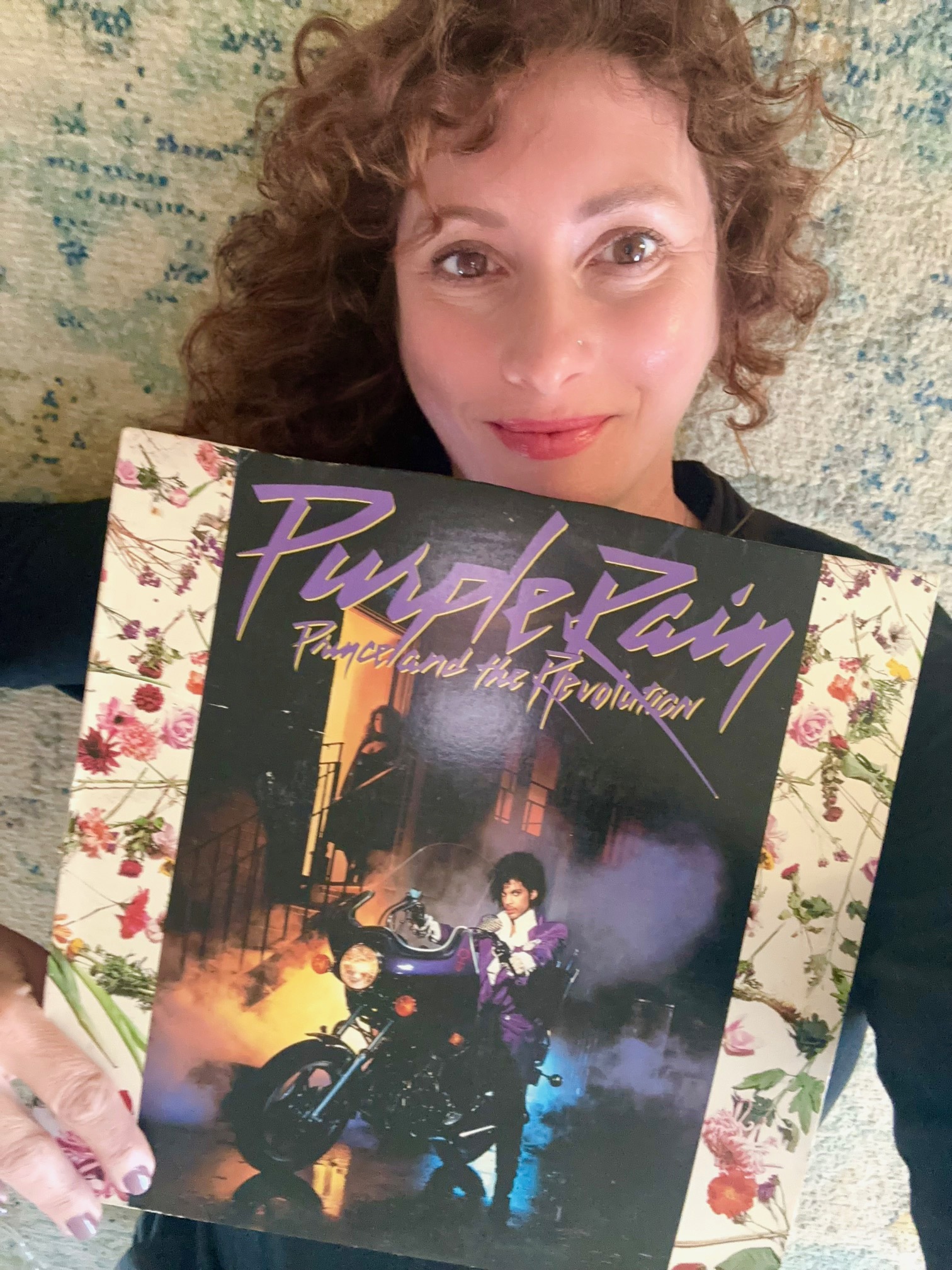
The Beastie Boys and Me
Published on Dec 10, 2025
The Doors and Me
Published on Dec 8, 2025
Hold the Line: a breakup story starring Toto
Published on Dec 3, 2025
Letter From the Publisher
Published on Nov 29, 2025
More Liner Notes…
Featured Essay: The Church of Purple Rain
by Maggie Downs

When I was eight years old, I thought the world was fine. Not amazing. Not terrible. Just fine. Which is not a dangerous kind of childhood, but it’s not good either.
This was Ohio, 1984. Our little corner of it was framed by strip malls that all looked like someone had photocopied a Sears and lost resolution. We had a shag carpet the color of canned pumpkin. Our family outings involved the salad bar at Ponderosa, where “fancy” meant a maraschino cherry in your 7-Up, and the steaks always came out gray. No one talked about feelings unless it was a stomachache, and even then, you were encouraged to walk it off. But I had books, a record player, and an imagination with extra square footage, so I mostly lived inside my head.
And then Purple Rain arrived.
It wasn’t mine. It belonged to Stacy up the street, who was allowed to watch MTV and wore her hair in braids secured by plastic barrettes shaped like bows. She brought the album over one late summer day, slid it across my kitchen table like contraband, and said, “You have to hear this.” Something about the album artwork — Prince astride a motorcycle, staring straight through me, eyeliner like battle paint — stirred something tectonic. A little fear. A lot of curiosity.
Of course, I’d heard Prince before. “Little Red Corvette” and “1999” had already been playing from passing cars and older siblings’ boomboxes — bright, bold songs that made you want to dance even if you didn’t fully get the words. But they hadn’t prepared me for this. What came through the speakers that day wasn’t just music. It was revelation. It was electric church.
The next thing I knew, I was lying on my back on the living room floor, listening to an invitation: “Dearly beloved, we are gathered here today to get through this thing called life.”
Prince didn’t sound like anyone from my world; he sounded like someone from beyond it. He screamed and whispered and moaned in ways that made me feel things I didn’t have language for yet. And suddenly, the clouds outside the living room window — those heavy, midwestern clouds that usually melted into the background like old furniture — started moving like they had somewhere better to be. Like I did too.
Looking back now, I realize I wasn’t just listening to an album. I was learning how to feel. Deeply. Unapologetically. Cinematically.
That was the year I started thinking in movie scenes. The school bus became a slow pan across a bleak emotional landscape. The hallway to my bedroom became a catwalk. Even brushing my teeth got a dramatic lighting upgrade. Prince had cracked something open. He gave me permission to see ordinary life with a filter turned all the way up: to turn loneliness into longing, boredom into desire, and suburban stillness into motion.
I had no idea at the time that my childhood was quietly starved of emotional vocabulary. I thought everyone felt like they were vibrating on the inside but couldn’t say why. It would take years (and many self-help books and late-night DMs with friends who were also unpacking their pasts) for me to understand that emotional unavailability is like carbon monoxide: invisible but quietly suffocating.
But Purple Rain? It gave me air. It said: Feel it all, even if no one else does. Especially if no one else does.
Fast forward a couple decades. A blur of jobs, address changes, heartbreaks and heart repair. Somewhere along the way, music — once an essential part of me — became background noise. I wasn’t listening anymore; I was consuming. Clicking. Skipping. Letting algorithms decide what I liked while I half-folded laundry or doomscrolled through the news. My relationship with music had gone limp. Muted. Practically transactional.
Then, this past January, I broke up with Spotify. A petty but righteous divorce. It started with politics but ended with something deeper, almost primal: I missed caring about my music. I missed album art and liner notes. I missed the ritual of listening, not just hearing. The tangible weight of a record in my hand, and the emotional weight it used to carry in my life.
For Valentine’s Day, my husband surprised me with a turntable. A real one. With a dust cover. A tonearm that floats like a question. A needle you gently place, not just a button to press. It was the most romantic thing anyone had given me in years, maybe ever.
I fell into it hard. Like a first crush. Within weeks, I was trawling thrift stores and dusty record bins with the fervor of someone trying to get a part of themselves back. And then, on a soft-lit Saturday, I found myself at a vintage market with my husband and 10-year-old son. We were flipping through a milk crate of LPs wedged between booths hawking retro cereal boxes and ironic ashtrays.
“How about this one?” my kid asked, holding an album in the air.
Purple Rain.
Something about that moment cracked me wide open. It was like my childhood had burst out of a manila envelope and hit me squarely in the chest. Suddenly I was eight again, knees scraped from falling off my banana-seat bike, heart full of questions I didn’t know how to ask. And now here was my kid, offering me a lifeline back to myself.
We brought it home. I carefully slid the record out of its sleeve like I was handling a relic. Placed it on the platter. Dropped the needle.
And then I did what my body told me to do: I lay down on the floor, face toward the ceiling, arms stretched out like I was trying to hug the whole sky. I didn’t move. Not until it was time to flip the album. And I swear, the room changed shape. The air got thicker, warmer. Time folded.
There it was again — that strange, sacred feeling. Like music could act as gravity. Like it could tether me to the planet when everything else felt slippery.
My son walked in during “The Beautiful Ones.” He didn’t say anything, just curled up next to me on the rug. I think he understood, even if he didn’t have the words for it yet.
This is what music does, when it’s at its most holy: it doesn’t just score your memories, it reassembles them. It carves out hidden hallways between who you were and who you’ve become. And some days, if the light hits right and the needle lands just so, you get to slip through one of those corridors, barefoot, breath held, heart open.
That day I lay on the floor and let Purple Rain wash over me again, I didn’t just feel nostalgic, I felt reassembled. As if some internal frequency, long silent, had started humming again. I wasn’t eight years old. But I also kind of was. I was a grown person, curled around the ghost of a kid who used to lie face-up on the carpet, staring at the clouds like they were carrying answers.
Now I know Purple Rain is not just a record. It’s a room I can still walk into. The scent of dust in sunlight. The ache of wanting more than the strip malls and dinner rolls and unspoken rules. Of believing, even just for a minute, that there was something bigger than what I could see from my front yard and that someone like Prince might just lead me toward it.
This album taught me how to feel, yes. But more than that, it taught me how to remember with gentleness. How to look back without flinching.
Because growing up doesn’t always mean moving forward in a straight line. Sometimes, it means turning in slow, careful circles. Returning to where you began. Dropping the needle. And hearing an old song ring out like it’s brand new again.
Maggie Downs is a journalist and author, specializing in outdoor adventure, wellness, and meaningful travel. Her work has appeared in the Wall Street Journal, the New York Times, the Washington Post, Travel + Leisure, Afar, and McSweeney’s, among others. Her memoir, BRAVER THAN YOU THINK, chronicles the year she spent backpacking around the world solo to complete her dying mother’s life goals. She is also the author of 50 THINGS TO DO BEFORE YOU’RE FIVE, a guide to gentle family adventures. She lives in California.

